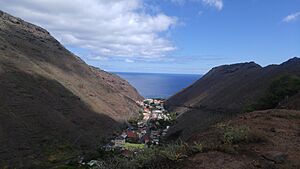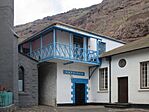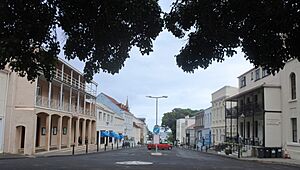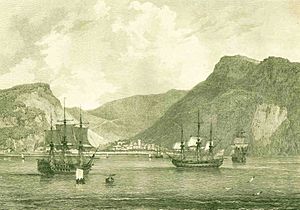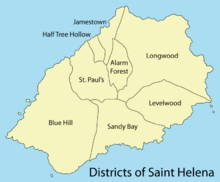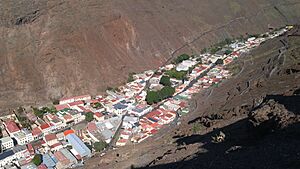Jamestown, Saint Helena facts for kids
Quick facts for kids
Jamestown
|
|
|---|---|
| City of James Town | |
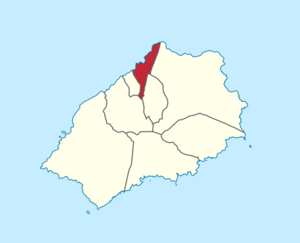
Jamestown in Saint Helena
|
|
| Country | |
| British overseas territory | |
| Island | |
| Status | City (1859); District |
| First settled | 1659 |
| Founded by | English East India Company |
| Named for | James, Duke of York |
| Capital of | Saint Helena; Saint Helena, Ascension and Tristan da Cunha |
| Area | |
| • City | 3.6 km2 (1.4 sq mi) |
| Population
(2016)
|
|
| • City | 629 |
| • Density | 198.3/km2 (514/sq mi) |
| • Urban | 1,614 (Jamestown and Half Tree Hollow) |
| Time zone | UTC+0 (GMT) |
| Area code(s) | +290 2xxx |
Jamestown is the capital city of a special British territory called Saint Helena, Ascension and Tristan da Cunha. It is found on Saint Helena island in the South Atlantic Ocean. Jamestown is the main town on the island and is located on its northwest coast. For a long time, it was the island's only port. It was also the center for all roads and communication.
The town was started in 1659 by settlers from the English East India Company. In 1673, the Dutch East India Company briefly took control, but the English soon got it back. Many buildings from the 1700s are still standing. They give the town a special Georgian look.
In 1815, the famous French leader Napoleon stayed in Jamestown for a short time when he was exiled to St. Helena. Later, the town became a base for the Royal Navy. The Navy worked hard to stop the slave trade. Jamestown did not play a big part in the First World War and only a small part in the Second World War.
Contents
History of Jamestown
Jamestown was founded in 1659 by the East India Company. This company was a powerful English trading group. The town was named after James, Duke of York. He later became King James II of England.
A fort was quickly built and first called the Castle of St John. In 1660, after the king returned to power, the fort was renamed James Fort. The town became Jamestown, and the valley was called James Valley. The fort and its gun batteries protected James Bay. They were improved many times over the years.
In January 1673, the Dutch East India Company took over the island for a short time. But the English East India Company got it back in May. Since then, the town has always been under English and then British rule.
After he lost the Battle of Waterloo in June 1815, Napoleon gave up to the British. He was sent to St. Helena. He arrived on October 21 on a ship called HMS Bellerophon. Napoleon lived at the Briars in Jamestown for a few months. In December, he moved to Longwood House, which was in a more distant part of the island.
Jamestown was also chosen to help stop the slave trade. The British Navy used it as a base to stop ships carrying enslaved people between Africa and the Americas. Ships that were captured were often brought to Jamestown. The people on board were rescued and brought to Rupert's Valley.
By the 1870s, when the naval base closed, about 25,000 enslaved people had been rescued. Sadly, about 5,000 died soon after arriving. They were buried in Rupert's Valley. Their graves were lost for a long time. They were found again in 2006 during digging for the airport. In 2008, archaeologists came to dig up the graves. Some items found are now shown at the International Slavery Museum in Liverpool, England.
The island was too far away to be involved in the First World War. It played only a very small part in the Second World War. An oil tanker called RFA Darkdale was sunk in James Bay on October 22, 1941. Only nine of its 50 crew members survived. The ship had been sent to St. Helena to refuel other ships. The sunken ship leaked small amounts of oil until June 2015. At that time, a team of divers pumped out all the remaining oil.
Geography and Description
Jamestown is built on igneous rock, which is rock formed from cooled lava. It sits in the James Valley, surrounded by very steep cliffs. This means the town is quite long and narrow. The valley walls are rough and steep. Falling rocks used to be a problem, but now nets help keep people safe. A small stream, called the Run, flows through the valley.
The city is often split into lower and upper parts. This depends on how far up James Valley you go. Jamestown is the island's main port. The Saint Helena Airport only started receiving regular flights in October 2017. So, the city is still the main way visitors arrive on the island.
Rupert's Valley is the next valley north of Jamestown. It is also part of the city, even though there is no road connecting it directly to Jamestown. This valley holds much of the island's important buildings. These include the power station and its fuel storage. A wharf (a place for ships to dock) was finished there in June 2016.
Jamestown has over 100 listed buildings. Most of these are from the Georgian era. Main Street has been called "one of the best examples of unspoilt Georgian architecture anywhere in the world." Many buildings are made from local volcanic rock. St James' Church was built in 1772. It is the oldest Anglican church in the Southern Hemisphere.
Another famous feature of the city is Jacob's Ladder. This is a staircase with 699 steps. It was built in 1829 to connect Jamestown to a former fort on Ladder Hill. The ladder is very popular with tourists. It is lit up at night. Every year, people from all over the world come to take part in a timed race up the ladder. The Museum of Saint Helena is in Jamestown. It is one of two museums on the island. The other is Longwood House.
Formal Status
Jamestown is officially a city. It was given this status by Queen Victoria in 1859. Its full name is the "City of James Town." It is also one of the 8 districts (administrative areas) on the island. Jamestown is the capital of both Saint Helena island and the British overseas territory of Saint Helena, Ascension and Tristan da Cunha. The Castle is one of the oldest buildings in the city. It is one of the main government buildings.
Climate
Jamestown has a tropical hot desert climate. This means it is hot and dry, but temperatures stay about the same all year. Even though it is a desert climate, the nearby ocean and cool currents keep temperatures from getting too hot. So, it is rarely extremely hot in Jamestown.
The temperature in Jamestown is about 5°C warmer than the rest of the island. This is because Jamestown is at a lower altitude. Jamestown gets less than 5 inches (13 cm) of rain each year. The higher parts of the island get more rain than the city. Jamestown is on the drier coast and in a sheltered spot. The highlands above Jamestown can get up to 39 inches (99 cm) of rain per year. These areas are full of green plants. The ocean waters around Jamestown can sometimes be very rough. There is a sea wall to protect the town.
| Climate data for Jamestown | |||||||||||||
|---|---|---|---|---|---|---|---|---|---|---|---|---|---|
| Month | Jan | Feb | Mar | Apr | May | Jun | Jul | Aug | Sep | Oct | Nov | Dec | Year |
| Record high °C (°F) | 31.7 (89.1) |
32.2 (90.0) |
33.3 (91.9) |
33.9 (93.0) |
28.3 (82.9) |
27.2 (81.0) |
26.1 (79.0) |
25.6 (78.1) |
25.6 (78.1) |
25.6 (78.1) |
26.7 (80.1) |
27.8 (82.0) |
33.9 (93.0) |
| Mean daily maximum °C (°F) | 26.7 (80.1) |
27.2 (81.0) |
27.8 (82.0) |
27.2 (81.0) |
24.4 (75.9) |
23.3 (73.9) |
22.2 (72.0) |
22.2 (72.0) |
22.2 (72.0) |
22.8 (73.0) |
23.3 (73.9) |
24.4 (75.9) |
24.5 (76.1) |
| Daily mean °C (°F) | 23.6 (74.5) |
24.2 (75.6) |
24.8 (76.6) |
24.2 (75.6) |
21.9 (71.4) |
20.8 (69.4) |
19.7 (67.5) |
19.7 (67.5) |
19.7 (67.5) |
20.3 (68.5) |
20.8 (69.4) |
21.6 (70.9) |
21.8 (71.2) |
| Mean daily minimum °C (°F) | 20.6 (69.1) |
21.1 (70.0) |
21.7 (71.1) |
21.1 (70.0) |
19.4 (66.9) |
18.3 (64.9) |
17.2 (63.0) |
17.2 (63.0) |
17.2 (63.0) |
17.8 (64.0) |
18.3 (64.9) |
18.9 (66.0) |
19.1 (66.4) |
| Record low °C (°F) | 17.2 (63.0) |
18.9 (66.0) |
18.9 (66.0) |
17.2 (63.0) |
16.1 (61.0) |
16.1 (61.0) |
14.4 (57.9) |
15.0 (59.0) |
14.4 (57.9) |
15.6 (60.1) |
16.7 (62.1) |
15.6 (60.1) |
14.4 (57.9) |
| Average precipitation mm (inches) | 8 (0.3) |
10 (0.4) |
20 (0.8) |
10 (0.4) |
18 (0.7) |
18 (0.7) |
8 (0.3) |
10 (0.4) |
5 (0.2) |
3 (0.1) |
0 (0) |
3 (0.1) |
114 (4.5) |
| Average rainy days | 4 | 4 | 5 | 3 | 4 | 6 | 8 | 3 | 2 | 0.7 | 0 | 1 | 41 |
| Average relative humidity (%) | 63 | 65 | 64 | 65 | 72 | 72 | 74 | 76 | 75 | 72 | 72 | 65 | 70 |
| Source 1: Sistema de Clasificación Bioclimática Mundial | |||||||||||||
| Source 2: BBC Weather, Danish Meteorological Institute (humidity 1931–1960) | |||||||||||||
Population
In 2016, the Jamestown district had 629 people living there. This was a drop from 714 people in 2008. The city's population has been getting smaller. It is no longer the biggest town on the island. Other places like Half Tree Hollow, Saint Paul's, and Longwood now have more people.
Education
Since Saint Helena is a British territory, it follows the British education system. There is one primary school in Jamestown called Pilling Primary School. It teaches children from ages four to eleven. This school was formed in September 2007 by joining Jamestown First School and Pilling Middle School. The island's only secondary school is Prince Andrew School. It is located in Saint Paul's.
Religion
The Anglican Parish of St. James is one of three parishes (church areas) on the island. St James' Church is the main church in this parish. It is the oldest Anglican Church in the southern hemisphere. The current building was put up in 1772.
There are three other smaller churches connected to St. James' Church:
- St John's, in Upper Jamestown
- St Mary's, at the Briars
- St Michael's, in Rupert's Valley
The only Catholic Church on St. Helena, Sacred Heart Church, is also in Jamestown. There is also a Baptist church in the city.
Images for kids
See also
 In Spanish: Jamestown (Santa Elena) para niños
In Spanish: Jamestown (Santa Elena) para niños


